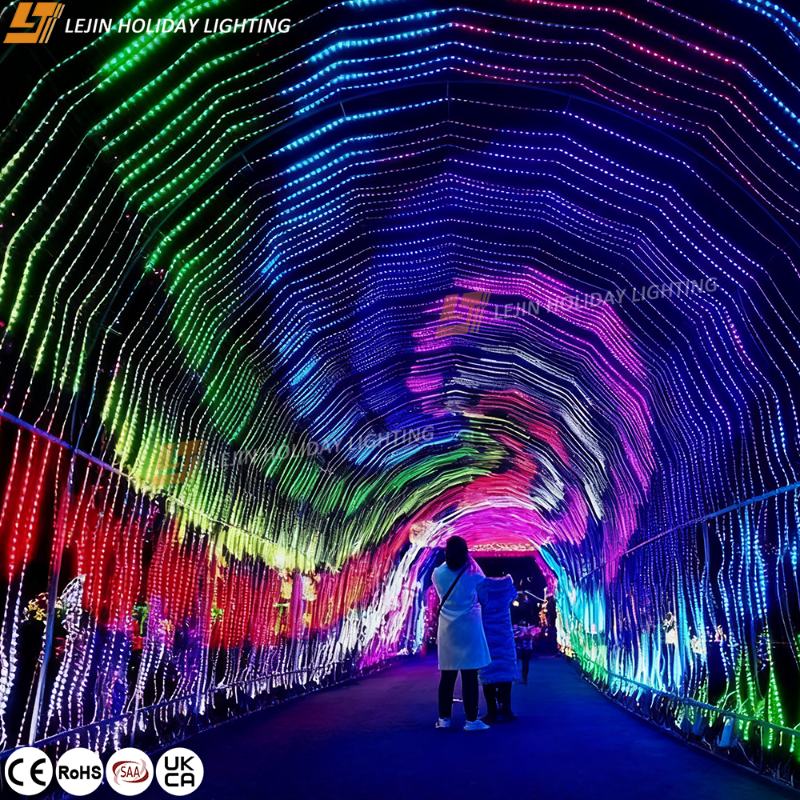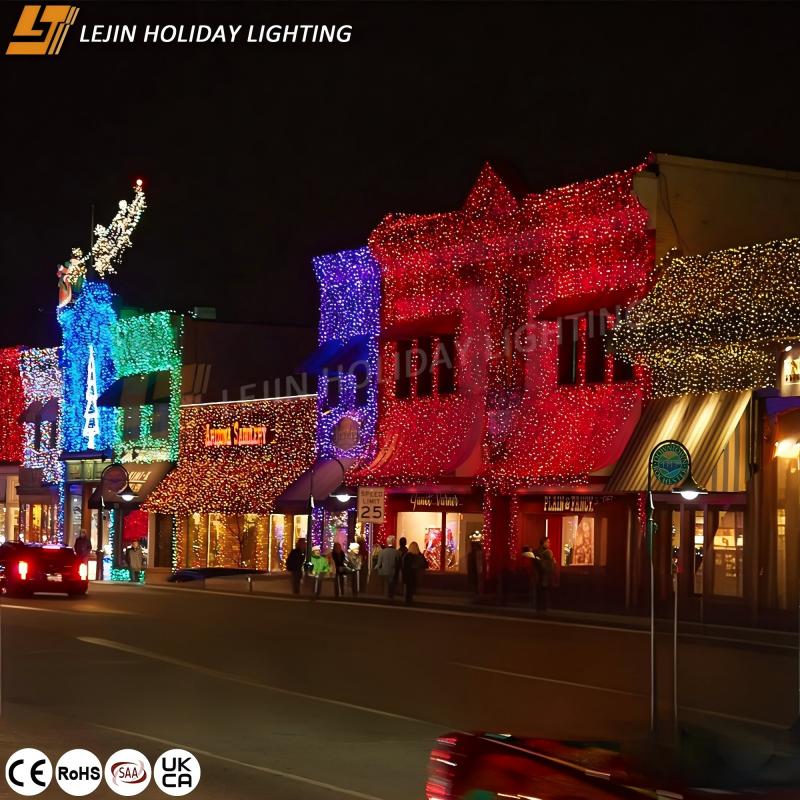The "Intelligent Transformation" of Christmas Decorative Lighting: A Comprehensive Upgrade from Single Luminaires to Scene-Based Control
Sep 09, 2025
Bottlenecks of Traditional Christmas Lighting: The Demand Gap from "Lighting Up" to "Using Well"For a long time, the core demand for Christmas decorative lighting has remained at the basic level of "lighting up the scene", and traditional solutions have gradually exposed various problems in practical applications. When decorating municipal streets, hundreds of meters of outdoor Christmas string lights require manual adjustment of brightness and switch status for each lamp. In cold, rainy, or snowy weather, maintenance personnel have to repeatedly climb high to troubleshoot faults, which is not only inefficient but also poses safety risks. In commercial spaces such as shopping malls and pedestrian streets, traditional lamps mostly adopt a single constant-on mode, unable to adjust lighting effects according to changes in holiday themes, making it difficult to create an immersive festive atmosphere. In addition, traditional lighting lacks effective energy consumption monitoring methods, leading to power waste due to over-lighting, while the decentralized control method forces operation and maintenance teams to invest a lot of manpower in daily inspections. As foreign cities have increasingly higher requirements for "quality" and "refinement" of holiday decorations, the shortcomings of traditional lighting—"emphasizing installation over experience" and "prioritizing investment over efficiency"—have become more prominent. The demand gap from "simply lighting up" to "using efficiently" has gradually emerged, making intelligent transformation an inevitable trend.
Core of Intelligent Transformation: Logical Reconstruction from "Single-Point Control" to "Scene-Based Linkage"The intelligent transformation of Christmas decorative lighting essentially upgrades the control logic from "managing each lamp individually" to "linked control based on scene needs". In the traditional model, each string of lights and each group of festive motif lights are independent entities that require separate operations and cannot form a synergistic effect; the intelligent solution, however, takes "scene needs" as the core and integrates scattered lamps into an organic whole. For example, in municipal Christmas decorations, a "festival peak mode" can be preset through the system to link all lamps, synchronously switch dynamic lighting effects, and create a lively scene with music. Scene-based linkage transforms Christmas lighting from "isolated decorative elements" into "intelligent systems serving scene needs", truly realizing "lighting adjusted on demand and effects adapted to scenes".
Technical Cornerstone of Intelligent Christmas Lighting: Dual Support from Hardware Upgrading and System SynergyThe implementation of intelligent Christmas lighting relies on the coordination of hardware upgrades and software systems. In terms of hardware, core components have achieved three major breakthroughs: First, the advancement of lamp bead technology—low-power LED lamp beads not only have a wider brightness adjustment range but also can work stably in environments ranging from -40℃ to 50℃, with waterproof performance to adapt to complex outdoor conditions. Second, the intellectualization of controllers: wireless intelligent controllers support multiple wireless communication methods such as Bluetooth, enabling three-level control (single lamp, group, and overall) with fast response speed to avoid lag in lighting switching. At the same time, the system supports interface functions, which can connect with municipal management platforms and management systems of commercial complexes to achieve data intercommunication and provide support for overall scene management. The dual support of hardware and software has turned intelligent Christmas lighting from a concept into a stable and reliable practical solution.
Scene-Based Implementation Practice: Analysis of Intelligent Lighting Solutions from Municipal Streets to Commercial SpacesThe scene value of intelligent Christmas lighting is particularly reflected in the practical applications of two core fields: municipal and commercial. In municipal street decoration, take the Christmas renovation project of a small European city as an example: The project adopts a combination of smart LED string lights and 2D snowflake motif lights, and divides the city's 12 main roads into 3 control areas through the system. The operation and maintenance team can remotely adjust the brightness and flicker frequency of each area through the background without on-site operations; when a fault occurs in a section of the string lights, the system can locate the fault point within 5 minutes, increasing maintenance efficiency by 4 times compared with the traditional model. In park scenes, intelligent 3D Santa Claus motif lights are linked with ground decorative string lights—when tourists approach, the sensor device triggers the dynamic expressions of the motif lights and the "starlight spread" effect of the ground string lights, enhancing the interactive experience. In commercial scenes, the solution of a North American shopping mall is more representative: It binds smart Christmas curtain lights, LED string lights with the mall's music system and guidance system, and automatically turns on the "Christmas theme mode" at 18:00 every day—curtain lights simulate snow falling, atrium string lights change colors with music rhythm, and guide signs simultaneously mark the locations of "Christmas markets" and "parent-child activities", extending customers' stay time through lighting linkage. These cases show that intelligent lighting solutions are not simply replacing lamps, but providing one-stop services of "product selection + system customization + effect design" according to the needs of different scenes.
Whole-Life Cycle Value: How Intelligent Solutions Balance Initial Investment and Long-Term Operation & Maintenance CostsFor Christmas decoration projects, the value of intelligent solutions lies not only in improving experience but also in optimizing costs throughout the entire process from purchase, installation to daily maintenance and replacement. Although the initial procurement cost of intelligent Christmas lighting fixtures is 20%-30% higher than that of traditional products, their cost-performance advantage is significant in the long run. During the installation phase, smart string lights adopt a "plug-and-play" design, eliminating the need for complex wiring, increasing installation efficiency by 50% and reducing labor costs by 30%. In the operation and maintenance phase, remote monitoring and fault alarm functions reduce 90% of on-site inspection workload—for a Christmas decoration project covering 10 kilometers of streets, the traditional solution requires a 6-person operation and maintenance team, while the intelligent solution only needs 2 people to complete the work. In terms of energy consumption, intelligent dimming and timed shutdown functions reduce overall energy consumption by 20%-40%. Based on a 2-month usage period during the Christmas season and commercial electricity unit prices, a project with 1,000 lamps can save about 1,200 US dollars in electricity bills. In addition, the service life of intelligent lamps can reach 5-8 years, far exceeding the 2-3 years of traditional lamps, significantly reducing replacement costs. From a long-term investment perspective, intelligent Christmas lighting solutions achieve a balance between initial investment and long-term value through multiple advantages of "reducing costs, improving efficiency, and saving energy".
Read More

